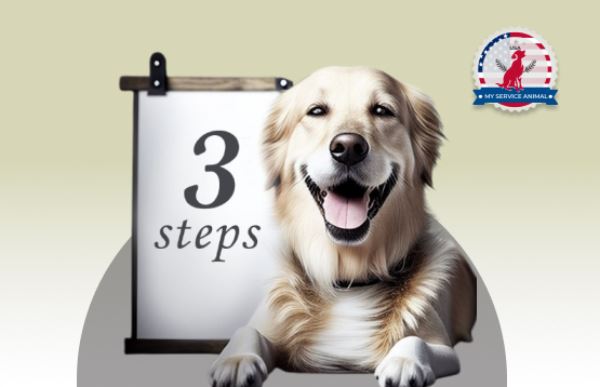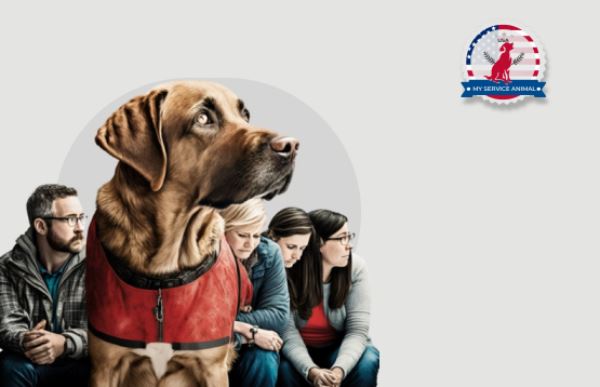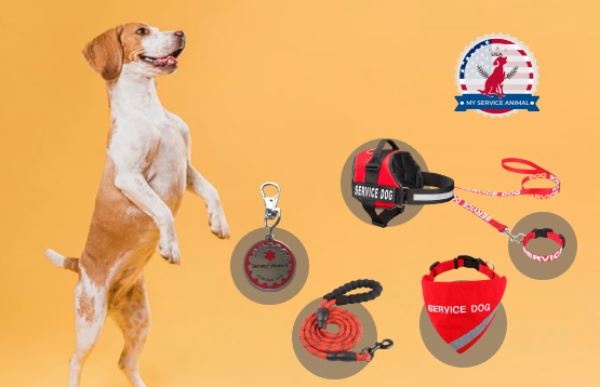Specially trained animals have been used for many years in various areas of life for various needs. One of these special categories is therapy dogs, which provide support to people who find themselves in difficult life situations.
In this article, you will be able to find all the information about therapy animals and learn how to become the owner of such a creature.
How Does Pet Therapy Work?

Pet therapy is one of the possible types of additional treatment for people with physical disabilities or mental illnesses. Its essence lies in the controlled interaction of the patient with specially trained animals. Animal-assisted therapy helps relieve pain and anxiety among individuals experiencing multiple conditions.
Even though therapy dogs receive a certain level of training, they are still not service dogs. They should not be able to perform specific tasks or provide 24-hour supervision of their patient. Usually, a therapy dog “works” in public institutions such as hospitals, nursing homes, orphanages, rehabilitation facilities, public schools, and disaster sites.
What do therapy dogs do?
Therapy dogs are tutored to contribute solace and easement to humans who are not their keepers. This mostly means visiting a variety of institutions where people need exceptional care and endearment, such as hospitals, schools, hospices, disaster areas, etc. Therapy animals help physical and occupational therapists take care of the patients and contribute to speeding up their recovery.
Connecting with a dog is an effective distraction for people suffering from mental disorders, depression, or those who feel lonely. For example, in homes for the elderly or in orphanages, where a dog is a friend for children and a creature they have to take care of. Through animal-assisted activities, therapy dogs help people cope with anxiety, comfort those who feel friendless, and give compassion and respect to people in difficult life circumstances
You can register your Therapy Dog in MyServiceAnimal Database.
What is the difference between a therapy dog and a companion dog?

Therapy dogs and emotional support animals can seem the same. The main purpose of these assistant animals is to support a person and strengthen his moral state. However, there are significant differences between them. For example, emotional support animals do not have to undergo any special training, while therapy animals receive special training before starting their duties. A therapy dog certification is an important document that confirms that the animal has the skills necessary to help people.
In addition, an emotional support animal is always close to its owner. Therapy dogs provide support to other people and do not have to be around patients 24/7. However, the law does not prohibit a therapy dog handler can use their animal as an ESA. In this way, the animal will be able to benefit and support not only you but also other people who need it.
Who can benefit from animal-assisted therapy?
Animal-assisted therapy can be useful for people of all ages and with various medical conditions. This includes both people with physical limitations, such as disabilities, or serious illnesses such as cancer, and people with mental disabilities. By using animal-assisted therapy and regaining pet care skills one can learn empathy and improve social skills.
Therapy dogs can help children with speech, hearing, or intellectual disabilities, such as Down syndrome, cerebral palsy, and autism. Using animal-aided therapy reduces stress and anxiety in people with various health problems. Moreover, for men with physical inabilities, therapy dogs are part of rehabilitation, as they help to train and adjust the load on some parts of the body.
Classification of therapy dogs
As with a service dog, there are several types of therapy animals. The kind of therapy dog depends on the animal-assisted activities it has to perform, as well as on the place where it will help people. There are 5 main types of therapy animals that are used most often:
- Therapeutic visitation dogs
Therapeutic visitation dogs are, in fact, household pets that are brought into hospitals or rehab facilities by their holders. For example, hospital patients and children from pediatric oncology nursing, who are forced to be apart from their families and therefore feel lonely, often become their wards. Therapy animals can also visit inmates in detention facilities.
Visits by a therapy animal contribute to human socialization and adaptation. Animals also help lift the spirit of their “client” and reduce anxiety and fear. Improving a person’s emotional state, in turn, leads to an improvement in a person’s physical health.
- Animal-assisted therapy dogs
Dogs that fall into this category are meant to aid patients in achieving determined recovery goals. These dogs are usually used in rehabilitation facilities and succor patients to develop such capabilities as motor skills, limb use, and hand-eye coordination. Animals help train and improve the skills important for normal human functioning by engaging patients in various activities and games.
- Facility Therapy Dogs
A Facility Therapy Dog mainly works in retirement homes, where they help people with Alzheimer’s disease. This disorder is characterized by disruption of brain processes, deterioration of memory, and concentration of attention.
A therapy dog guarantees people with this disease additional protection and minimizes the risk of a person getting into trouble. For the patient’s safety, his interaction with the animal takes place under the supervision of qualified personnel.
- Disaster Relief Dogs
Similar to therapeutic visitation dogs, disaster relief dogs can bring relief and consolation to those experiencing trauma or violence. People who have experienced traumatic events are very vulnerable and may be afraid to come into contact with other people. In such cases, the help of an animal is optimal. These can be both local events that affect a small number of people, and large-scale disasters, such as war or natural cataclysm.
- Reading therapy dogs
Reading therapy dogs have a companionship role in schools and libraries to help children who have learning disorders. Some students with reading problems develop low self-esteem and are self-conscious about reading when their peers listen to them.
A reading therapy dog is intended to sit beside kids and have a calming effect on the child. Animals do not express judgment and do not exert pressure on the reader, so a person can relax and develop his learning and reading skills in a favorable and calm environment.
Learn more about the Modern Use of Animal-Assisted Therapy Programs
Therapy Dog Breeds

Although the majority of therapy animals are dogs, other species also make excellent candidates for this role. For example, cats, guinea pigs, miniature horses, rabbits, gophers, and other animals can be used for therapeutic purposes. Everything depends on the functions that the animal must perform.
Yet, if you’re thinking of hiring dogs for therapy, you need a dog that has the temperament and ability to learn from the dog. The best therapy dogs must be calm and friendly in appearance. For instance, Labradors and Retrievers often make excellent therapy dogs for patients.
How to get a Therapy Dog: Therapy Dog Requirements
Before they can start helping people, therapy dogs must complete one of the training programs. Many therapy dog programs help teach animal obedience and basic patient care functions. Also, most institutions require that before the initial “work” the animal passes the American kennel club CGC test for acceptable behavior.
However, in addition to special training, a therapy dog must have certain behavioral characteristics. Therapy dogs should be comfortable at work in an active environment and be well-socialized. The therapy dog must always be confident and gentle in every situation. It is also important that the animal is friendly and does not tend to show aggression toward people or other animals.
Besides, to claim the status of a therapeutic dog, the animal must make a certain number of visits to the appropriate institutions. With each successful visit, the animal will have the opportunity to increase its title from Novice to Supreme.
- Therapy Dog Training
Almost every breed of dog is eligible to receive therapeutic dog certification if it has passed the required temperament tests. The main task of any therapy dog program is to make the animal obedient and polite so that it can safely participate in animal-assisted therapy.
Basic training includes training the dog’s reactions to people and other animals, reactions to interactions with patients, as well as reactions to the owner’s or handler’s voice, and following commands. If an animal fails the Canine Good Citizen Test, there is a high probability that it will not be able to become a therapy dog and will not be allowed to interact with people who need it.
If you are a pet owner and want your dog to become a therapy dog, you can register it for one of the training programs. If you don’t have an animal yet, you can become an owner of an animal that has already been trained. All therapy dogs must have a registration number and information about them is entered in a general register.
- Walking through a crowd
One of the main tasks of any service dog training program is to teach the animal to respond calmly to strangers and large crowds of people. During walks, the dog should not rush at people but should walk next to its owner. In addition, the animal must be gentle when it is petted or played with.
- Reaction to another dog
The benevolence and friendliness of a dog should be extended not only to people but also to animals. A good therapy dog should not react to other dogs, or be distracted by other animals, such as cats. Any manifestations of the dog’s unacceptable reaction to other cats can call into question its ability to calmly and non-aggressively interact with people in difficult situations.
- Fulfillment of commands
The dog must be able to recognize the owner’s voice and follow basic commands such as “sit”, “down” and “stay”. Also, the dog must respond when called. In addition to its owner, the dog must also obey the staff of the institution where it is located.
Appearance and grooming

Appearance is extremely important for a therapy dog. The animal must be regularly groomed and visit the veterinarian on time. The animal must be clean, combed, and with trimmed claws. It is also mandatory to have all the necessary vaccinations for the animal.
Before the animal begins to provide therapeutic services, its owner must show a certificate from a veterinarian that the animal is free of diseases, infections, and parasites, to have proof that the animal does not threaten patients’ lives
Does pet therapy have risks?
There is much controversy surrounding the safety and benefits of using therapy dogs. First of all, doctors are concerned about the hygiene and physical safety of animals for people. Passing the CGC test and animal health certificates is required to reduce these disputes. Moreover, human interaction with therapy dogs always takes place under the supervision of a person in charge.

























